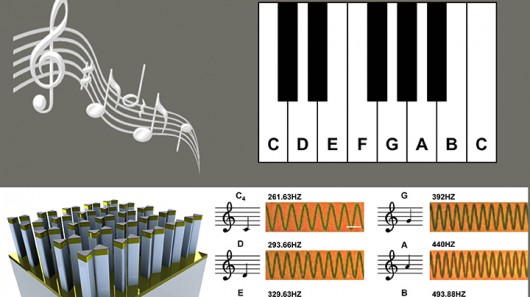
The use of optical sound-on-film recording on early movie films revolutionized the motion picture industry and remained the standard method of audio recording in that medium for more than 80 years. Now researchers from the University of Illinois have emulated that feat in miniature by claiming to have recorded the world's first optically encoded audio onto a plasmonic film substrate. The size of human hair, this substrate has a capacity over five-and-a-half thousand times greater than conventional analog magnetic recording media.
Requiring an area of just 0.0255 sq mm (0.000039 sq in) on the plasmonic film for one second of audio storage, compared to an area of 1,143 sq mm (1.77 sq in) needed for analog magnetic tape to capture the same length of recording, the storage capacity potential is very high, particularly as the storage medium itself is so incredibly thin. In essence, researchers working under the leadership of associate professor Kimani Toussaint recorded this optically encoded audio onto nanoantennas in a nonmagnetic plasmonic nanostructure by utilizing the ability of these pillar-supported, bowtie, gold nanoantennas (pBNAs) to emulate photographic film. In other words, by altering the reflective properties of nanoantennas to recreate certain optically-encoded frequency responses when illuminated, the team successfully recorded from middle C through (C4), D, E, F, G, A, B and on to tenor C (C5), thereby creating a plasmonic tuned keyboard or "nano piano", as the team has dubbed it. To do this, the team recorded sound signals using an audio-modulated tunable Titanium-Sapphire laser to focus a beam through a microscope to scan directly onto the pBNAs. To play back the recording – in this case, Twinkle, Twinkle, Little Star – the same microscope was used to transfer the recorded information to a digital camera, where signal processing was used to turn the optical patterns back into sound. "Data storage is one interesting area to think about," said Professor Toussaint. "For example, one can consider applying this type of nanotechnology to enhancing the niche, but still important, analog technology used in the area of archival storage such as using microfiche. In addition, our work holds potential for on-chip, plasmonic-based information processing." Previously having shown in other research that pBNAs are more prone to changes in heat to their structure than standard bowtie nanoantennas when subjected to low-powered laser light, the team used this technique to slightly melt the gold in each nanoantenna to "tune" them to a specific frequency response and, therefore, a different musical note. "A characteristic property of plasmonics is the spectrum," said Hao Chen, a former postdoc in Toussaint’s laboratory. "Originating from a plasmon-induced thermal effect, well-controlled nanoscale morphological changes allow as much as a 100-nm spectral shift from the nanoantennas. By employing this spectral degree-of-freedom as an amplitude coordinate, the storage capacity can be improved." The plasmonic film employed in this research can also be made to usefully record digital data too, if necessary, dependent upon the way the structure is configured using the laser-light manipulation. "... although our audio recording focused on analog data storage, in principle it is still possible to transform to digital data storage by having each bowtie serve as a unit bit 1 or 0," said Chen. "By modifying the size of the bowtie, it’s feasible to further improve the storage capacity." Currently, the Illinois researchers are looking at ways to combine both audio and video recordings on the one array of pBNAs. And, by utilizing nascent nanomanufacturing techniques (such as nanoimprint lithography), the team also believes it may be possible to mass produce these devices and explore other potential data storage applications, such as a replacement for analog technology in archival storage. This research could also significantly improve the development of on-chip, plasmonic-based information processing devices. The results were recently published in the journal Nature Scientific Reports.

 Previous page
Previous page Back to top
Back to top







